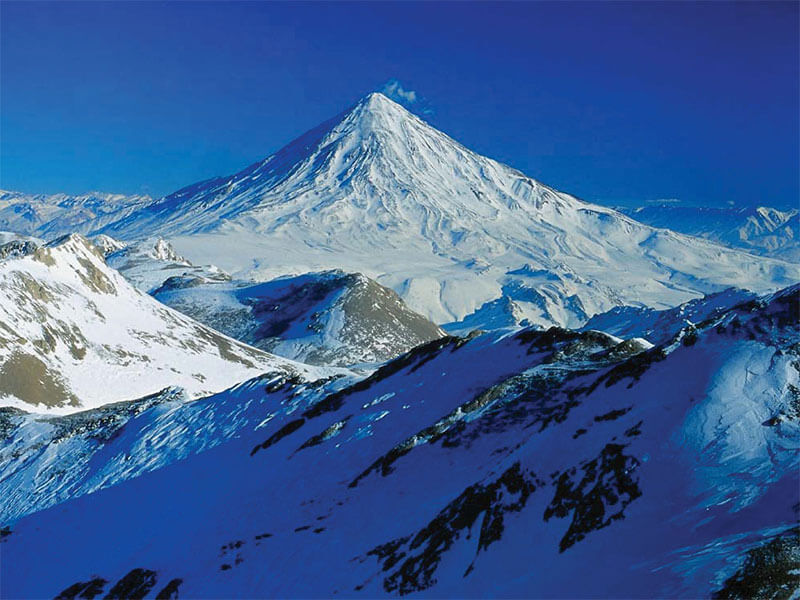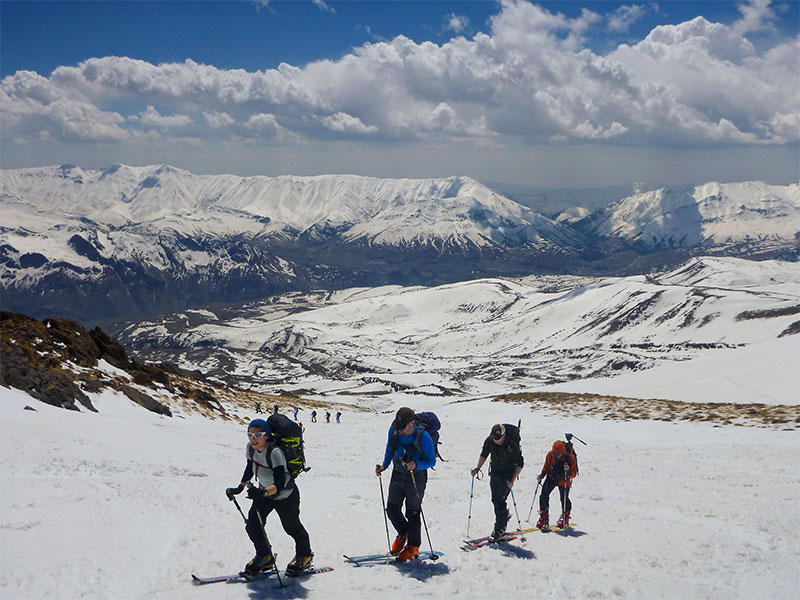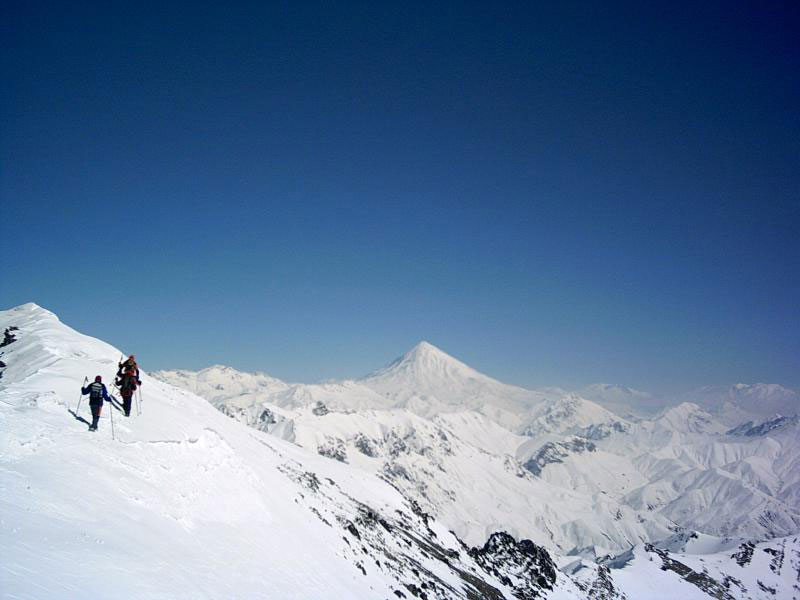
“The most affordable summit above 5000m, all around the world! The highest mountain in Iran! The most beautiful, semi-active volcanic, pyramid-shaped mountain you’ve ever imagined!” says an adventurer who has climbed Mount Damavand.
Damavand is a legendary peak! If you are planning to travel to Iran and you are fit and have a good physical condition and above all, you love extreme sports, it will be a delightful challenge to climb Mount Damavand, a high peak known as the “roof of Iran” with an altitude of 5671 meters. Mount Damavand is the 12th most prominent peak in the world and the second one in Asia after Everest. Mount Damavand is the highest part of the central Alborz range about 70km northeast of Tehran and south of the Caspian Sea. Europeans were the first to climb to the Damavand peak during the Safavid dynasty at the late monarchy of Nasser-al-Din Qajar. He was the first Iranian who made it to ascend the peak. This old, marvelous, and unique conical dormant volcano is a desirable and attractive climbing destination. Every year more than 100,000 mountaineers climb Mount Damavand to the peak.
Being the highest volcano in the Middle East, Mount Damavand is a part of the Seven Summit project. Not only the Caspian Sea but also Iran’s central desert is visible from the summit. Mount Damavand is a symbol of sustainability in Persian culture and has been registered as a national natural heritage. It is also one of the most unique ecosystems in Iran, as it reaches a dry desert in the south and the rain forests from the north flank. Damavand peak is easily achievable for most people with a good physical condition and enough experience, everyone can reach the summit in a few days. So the main question is: “why shouldn’t you plan to climb Mount Damavand?”

Mount Damavand is a high peak known as the “roof of Iran” with an altitude of 5671 meters.
Damavand edges and routs
Mount Damavand has Overall 28 specified edges including sideways. 4 main paths in South, North, Northeast, and west are normal routes of Damavand. The easiest route to reach the summit is hiking from the southern flank in summer which starts from Rineh village to Goosfandsara (Camp II) and Bargah-e-Sevom (CampIII) and then climbing to the peak.
Damavand climate
Mount Damavand has special weather conditions due to its solitariness and its conical shape. In winter during a storm or blizzard, the minimum temperature varies from -40° C at the midway of the summit to -60° C at the peak. Even in summer, the temperature reaches -1 or -2° C at higher altitudes. This low temperature depends not only on the flank but also on the speed of the wind on that side. The speed of the wind differs from 150 to 70km/h at foothills in bad weather conditions. The wind often blows from the west and northwest, so, the north face is the coldest route of Damavand, however, the cold weather dominates less in the southern route since it remains in shadow until noon and midday. Therefore climbing in such a situation requires enough experience and equipment to avoid the risk of freezing. The average rainfall in Damavand is 1400mm per year which is usually snow. The air pressure at the peak is half the air pressure at sea level.
When to climb Mount Damavand?
Depending on the purpose of your trip, you can come to Damavand in all seasons to enjoy its beauty. For instance, if you intend to go mountain trekking and climb the summit, the best season would be summer in July and August. For professional and technical mountaineering, you should come certainly in winter in January and February. Damavand shelters are On its main routes – north, south, northeast, and west- totally, there are seven shelters, bivouacs, and cottages with basic facilities.
- The shelters on the southern edge are Goosfandsara and Sahib Al-Zaman Mosque at an altitude of 3000 meters, old Bargah-e-Sevom building at 4200 meters with camping facilities and cottages located 50 meters above including public storage room, dining room, kitchen, electricity, public bedroom, and bathroom, and a private bedroom.
- The Simorgh shelter on the western edge at the height of 4200 meters.
- On the northeastern edge stands Takht-e-Fereydon bivouac at 4400 meters.
- There are 2 bivouacs on the northern edge at the height of 4000 and 5000 meters. According to the definition of Base Camp, the 3 guesthouses in Polour, Rineh, and Nandal villages can be considered as base camps of Mount Damavand.
Accommodation
There are 3 guesthouses in Polour, Rineh, and Nandal villages in the Damavand area with limited facilities like bedrooms; bathrooms, kitchen and etc. Book your space before arriving at the area, especially in high season it is necessary. Renting a private room in local houses of the area is also another alternative.
How long does it take to climb Mount Damavand?
Your body condition, physical fitness, season, acclimatization, and weather condition are determinant factors affecting the time of climbing. In summer, ascending Damavand takes about 4 to 5 days to reach the peak while in winter it takes more than 7 days. However, some strong and acclimatized climbers can reach the summit in less than 24 hours.
Training to climb Mount Damavand
The type of training and exercises to reach the ideal fitness for ascending Damavand depends relatively on your age, health, and mountaineering experiences. Taking aerobic exercises 3 to 4 times a week along with hill hiking carrying a backpack in different weather conditions, running or cycling will be very beneficial.

Prepare yourself before climbing Mount Damavand otherwise, you won’t be able to climb all the way. It is usually a 2 to 3 days job.
Acclimatization
The most important issue for safe climbing is the acclimatization process. Getting used to the height, low air pressure, and the lack of oxygen is the key to prevent symptoms that occur until you are fully synced with existing air. These symptoms and their intensity vary from person to person, but the most common ones are headaches, nausea, and dizziness. You can well deal with these problems by doing a climb of 4500 meters high and returning to the shelter.
Necessary gears to climb Mount Damavand
Before climbing Mount Damavand makes sure to take the required stuff, you should have this equipment, no joke!
Large backpack or duffel bag to carry your gadgets with a mule, 4WD cars or leave in guesthouse, a small backpack for climbing equipment on the route, bag cover or collar, proper tent for the height, sleeping bag (with a Comfort of -10 temperature), whistles, climbing batons, jackets, and windbreakers or gore-tex, polar jackets and trousers, first layer shirts and trousers, second layer shirts, suitable climbing shoes, woolen soles or hand towels, anti-storm hats, sleeveless gloves polar and stuffed, sunglasses with strap (side shields or glacier glasses recommended), headlamp with additional lithium battery, gas cylinder, necessary container (knife, cup, spoon, fork …), thermos or bottle of water, GPS, camera, mobile and Power Bank, toothbrushes and toothpastes, paper napkins, wipes, notepad and pen, yarn and needle, personal first aid kit, sunscreen cream, and lip balm, small quantity of your favorite energetic snacks, identity card and if you are under certain treatment you should take your medicine for sure.
Food and drinks
The best foods for mountaineering are foods that are low-volume and high-calorie and do not rot easily. Honey, jam, dates, and nuts can be the main part of every meal. There are also local shops near the guesthouses in Polour and Rineh villages where you can find fresh fruits and vegetables. It is highly recommended to take 1.5 liters of water with you.
What are the common dangers of Mount Damavand?
Altitude sickness, losing path caused by an unexpected storm, fog and strong wind, extra cold weather, snow, land, rock and mudslide, lack of equipment and to insist on climbing Damavand summit during height-related symptoms are common hazards that every climber has to be ready to deal with.
Mountain guide
Accompanying an expert and professional mountain guide is another considerable factor to have a successful and safe ascend. If you are going to climb Mount Damavand within a group, it is important that at least one member of the group has already climbed to the summit and has the ability to support the others in case of any inconvenience.
Watch this exciting video of one of our adventure tours to Iran.
If you need more information about Climbing Mount. Damavand, visit our climbing and trekking tours in Iran and Damavand tour. For further questions and climbing tours please contact us at 0098 9197826753.
